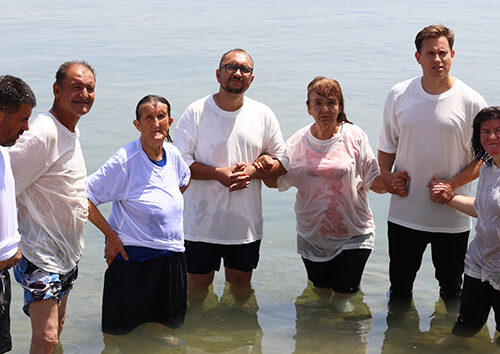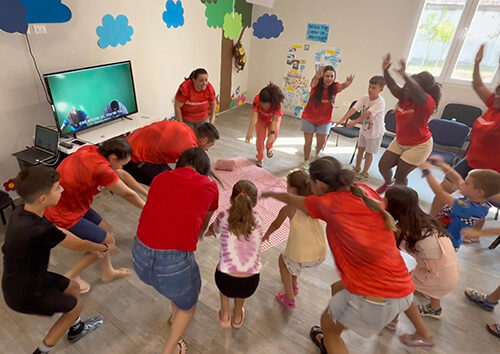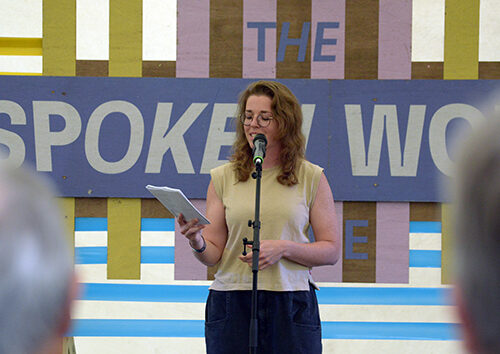 18 August 2016 | Hlíðardalsskóli, Iceland [Victor Hulbert] Until Tuesday, 9 August, most of the 75 delegates at the European Faith and Science Conference would have supposed that lava was only lava – the molten rock that flows out of volcanos destroying everything in its path. Now they are wiser – after all, spending a week on an island composed almost entirely of lava can quickly make you an expert, especially when accompanied by a local geologist.
18 August 2016 | Hlíðardalsskóli, Iceland [Victor Hulbert] Until Tuesday, 9 August, most of the 75 delegates at the European Faith and Science Conference would have supposed that lava was only lava – the molten rock that flows out of volcanos destroying everything in its path. Now they are wiser – after all, spending a week on an island composed almost entirely of lava can quickly make you an expert, especially when accompanied by a local geologist.
Seventy-five teachers, scientists, pastors and a large group of students travelled to Iceland, staying at the Adventist Church’s former boarding school, Hlíðardalsskóli, now run as a retreat centre for groups both in Iceland, across Scandinavia and more recently the UK. From 9 – 16 August they listened to lectures on issues of geology, biology and theology, asked the deep questions on problems surrounding creation and evolution, and went on field trips to discover the effects of both glaciation and volcanic activity. Delegates studied rock formations, looked at strata, identified whether the vast lava fields were pahoehoe, a’a’, or some intermediate forms, and discovered first-hand the challenges and beauty caused by living on a volcanic island that straddles the North-Atlantic ridge.
It may have been something to do with the unique nature and beauty of the Icelandic countryside, but event organiser, L James Gibson, director of the GeoScience Research Institute (GRI), found it easy to attract one of the largest groups of experts he had ever had to a GRI Field Conference outside of North America. In addition to an enthusiastic and knowledgeable local geologist, 14 experts lectured on subjects such as plate tectonics, fossils and the geologic column, or on practical subjects that directly impact the classroom.
 Raúl Esperante, a GRI palaeontologist, took a close look at evolution in school text books and demonstrated how they often hung on to old models that were not even recognised by modern evolutionary science. Noemi Duran, recently appointed as the GRI representative for Europe, bubbled with enthusiasm as she shared how the positive values of a Creationist world-view can undergird many aspects of learning in school, church and home.
Raúl Esperante, a GRI palaeontologist, took a close look at evolution in school text books and demonstrated how they often hung on to old models that were not even recognised by modern evolutionary science. Noemi Duran, recently appointed as the GRI representative for Europe, bubbled with enthusiasm as she shared how the positive values of a Creationist world-view can undergird many aspects of learning in school, church and home.
Suzanne Phillips, chair of Earth and Biological Sciences at Loma Linda University, dug down into molecular structure and looked at how the minute machines within the molecule point to a creator. “Every time I learn about a new process I really feel I learn something new about God,” she stated. As a biologist she claims she has the privilege of “studying about God more than any theologian!”
 Research reports, a discussion on radioisotope dating, a theology of creation, Q&A periods, field trips and devotional periods filled delegates days. Did it live up to their expectations?
Research reports, a discussion on radioisotope dating, a theology of creation, Q&A periods, field trips and devotional periods filled delegates days. Did it live up to their expectations?
Nina Bergene, a science teacher at Tyrifjord school in Norway confessed that she arrived somewhat sceptical as to how useful the conference would be. “I wasn’t prepared for the high standard of the scientific data,” she said. “I was a bit critical, but the way they presented the data and the fact that they are so humble when it comes to interpreting the data, that is very good.”
 That humbleness was exemplified by Leonard Brand, a professor of biology and palaeontology at Loma Linda University. He stated, “If we had all the answers, we would give them to you. We don’t have all the answers, there are many questions, but that is why we keep doing research.” While that is true for creation science, the open discussion was positive, as was equally the comment from Gibson, “The evolutionist world-view doesn’t have all the answers either. Both world-views have much to discover.”
That humbleness was exemplified by Leonard Brand, a professor of biology and palaeontology at Loma Linda University. He stated, “If we had all the answers, we would give them to you. We don’t have all the answers, there are many questions, but that is why we keep doing research.” While that is true for creation science, the open discussion was positive, as was equally the comment from Gibson, “The evolutionist world-view doesn’t have all the answers either. Both world-views have much to discover.”
Mark Szallos-Farkas, a Romanian teacher with an interest in apologetics, stated, “it encouraged me and inspired me to learn more about these things.” Norwegian teacher, Rene Havstein, appreciated just being able to “talk with scientists and people who know a whole lot more than me and also believe in the Bible.” Hungarian geologist, Judith Horvat, was grateful to be at the event as, she confessed, she has little opportunity to interact on the subject in her home country. “I think it is really important to see that as a geologist you can be a Christian,” she said.
 A husband and wife team, Ruben and Maria, from Sagunto Adventist College in Spain, both appreciated the meeting of minds during the conference, and the practical nature of the field trips. They have something positive to take back to their students. The same was true for Sharon Sinclair, a teacher at Stanborough School, England. She was delighted for increased scientific evidence that she could share with her students, that “God did indeed create our world.”
A husband and wife team, Ruben and Maria, from Sagunto Adventist College in Spain, both appreciated the meeting of minds during the conference, and the practical nature of the field trips. They have something positive to take back to their students. The same was true for Sharon Sinclair, a teacher at Stanborough School, England. She was delighted for increased scientific evidence that she could share with her students, that “God did indeed create our world.”
“I think the importance of having a group like this together, and being able to interact and discuss the issues openly, freely, and express our views, this is without parallel,” states Arthur Chadwick, a professor of biology and geology at Southwestern Adventist University, Texas. Artur Stele agrees. As a Vice-President of the Seventh-day Adventist World Church he is proud of the scholars he sees who are constantly involved in research. He sees great benefits in a Field Conference that brings together these scholars with Adventist teachers and pastors, sharing research, allowing for questions, and perhaps even stimulating ideas for further research.
 The local hosts of the Conference at the former Adventist boarding school were also delighted. Three families moved to Hlíðardalsskóli, 45km (30 miles) east of Reykjavik, in 1999, after the school finally had to close. While the changing education environment in Iceland forced the change, the families volunteered their time and invested their own finances to keep the place open as a retreat venue for groups, both from within Iceland and from abroad. This was the largest group they had hosted, but they were overwhelmed with the thanks they received for the quality, home-baked, plant-based menu, the friendliness, and the care they provided – all with a smile on their faces.
The local hosts of the Conference at the former Adventist boarding school were also delighted. Three families moved to Hlíðardalsskóli, 45km (30 miles) east of Reykjavik, in 1999, after the school finally had to close. While the changing education environment in Iceland forced the change, the families volunteered their time and invested their own finances to keep the place open as a retreat venue for groups, both from within Iceland and from abroad. This was the largest group they had hosted, but they were overwhelmed with the thanks they received for the quality, home-baked, plant-based menu, the friendliness, and the care they provided – all with a smile on their faces.
“Where else can you go where you get totally unpolluted spring water in your taps, a quiet, stunningly beautiful environment, geothermal heating, and a relaxed atmosphere for worship and learning – close to magnificent beauty spots,” stated one of the hosts, Elías Theodórsson. “I would not hesitate to come here again,” enthused Gibson. Both in terms of learning and environment, all the delegates would agree.
To find out more about GRI, downloadable resources and future field conferences, visit their website. http://grisda.org. To make enquires about booking Hlíðardalsskóli for your retreat, conference or youth event email Eric Guðmundsson: [email protected]. Several picture galleries of the Conference can be seen on the Trans-European Division Facebook page. [tedNEWS]
tedNEWS Staff: Victor Hulbert, director; Esti Pujic, editor
119 St Peter’s Street, St Albans, Herts, AL1 3EY, England
E-mail: [email protected]
Website: www.ted.adventist.org
tedNEWS is an information bulletin issued by the communication department of the Seventh-day Adventist Church in the Trans-European Division.
You are free to re-print any portion of the bulletin without need for special permission. However, we kindly request that you identify tedNEWS whenever you publish these materials.



